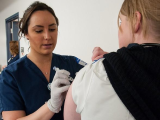Oct 29, 2010 (CIDRAP News) – School-based flu vaccines that target children with inhaled flu vaccine can head off infections and provide herd immunity even during seasons when circulating flu strains don't match the vaccine strains, a new study found.
The study uses data from the Central Texas Field Trial, which since 1998 has focused on delivering the inhaled live attenuated influenza vaccine (LAIV), MedImmune's FluMist, to children in eastern Bell County, Tex. The program's goal is to blunt the effect of seasonal flu in the community by increasing the number of children who are vaccinated, mainly through school-based clinics.
The study tracked flu patterns in children who received the vaccine in the fall of 2007. The findings appear in an early online edition of Journal of Infectious Diseases (JID).
Children who couldn't receive the LAIV vaccine, such as those with asthma, received the injectable trivalent vaccine (TIV).
During that flu season, three new antigenic variants circulated in the United States: a Brisbane H1N1 strain, a Brisbane H3N2 strain, and an influenza B virus from the Yamagata lineage.
After 48% of elementary school children were vaccinated in the fall of 2007, researchers measured herd immunity by comparing age-specific rates of doctor's visits for health plan members at the field trial site with those at control sites. Kids at the control sites received both versions of the vaccine, but not according to a set protocol.
Researchers detected levels of herd immunity linked to the LAIV vaccine for all age-groups, except 12- to 17-year-old students, a group that did not have access to the free vaccine. They found only marginal protection among students who received the TIV.
The group estimated that the vaccination strategy prevented about 2,500 medical encounters at the intervention site.
LAIV provided significant cross-protection to the immunized children and indirectly protected others in the community, the authors concluded. They also wrote that their results highlight the value of immunizing school children as a means of dampening the spread of flu in a community.
In an editorial on the study that appeared in the same issue of JID, Dr Edward Lewin, a pediatrician from Bethesda, Md., wrote that the study supports using the influenza's epidemiology as a tool for controlling the disease. Lewin is on the board of trustees of the National Foundation for Infectious Diseases.
He wrote that risk-based approaches, such as promoting the vaccine in older people, have not been effective in preventing flu infections and deaths.
Herd immunity has been a useful tool in the fight against other viral diseases such as rubella, measles, and mumps, and that evidence is mounting that it can be used to control influenza, as well, he added.
Lewin said LAIV is a good fit for school-based vaccine clinics because it has greater efficacy than TIV in children and long-lasting immunity, has significant activity against mismatched strains, and is easy to administer.
School-based flu shot clinics provide a good platform for achieving a herd effect, he wrote. "Having our armamentarium of influenza vaccines, particularly LAIV, administered where these young people congregate—that is, at school—is good public health policy and represents sensible planning for the control of pandemic influenza."
See also:
Oct 28 JID abstract
Oct 28 JID editorial citation



















